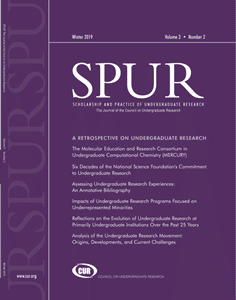SPUR (2019) 3 (2): https://doi.org/10.18833/spur/3/2/6
More Articles in this Issue
- Assessment‐ Mary Crowe and David Brakke
SPUR (2019) 3 (2): https://doi.org/10.18833/spur/3/2/3 Abstract:In the past decade, the assessment of undergraduate research experience (URE) and course-based undergraduate research (CURE) has evolved and significantly expanded, with hundreds of studies published in books, white papers, technical reports, and academic journals. Much of the work has focused on the impact of URE and CURE on students, leading to new insights about the importance of mentoring and student self-efficacy and the identification of essential features of URE and CURE. Studies focusing on the impact of URE on faculty members and institutions have remained limited. The advent of a variety of assessment instruments and the spread of this high-impact practice across all academic fields suggest that the timing is ripe for new areas of study.
- Practice‐ Susan Rundell Singer
SPUR (2019) 3 (2): https://doi.org/10.18833/spur/3/2/7 Abstract:For 60 years, the National Science Foundation’s commitment to undergraduate research experiences has shaped the course of undergraduate research opportunities, from apprenticeship model–based experiences to team-based and classroom-based collaborations for a diverse group of students. Scaling the opportunity so that students may participate in an equitable and inclusive way has been a priority since the inception of the program. Applying the growing research base in undergraduate science, engineering, and mathematics education to development of optimal research experiences for undergraduates is the next frontier.
- Practice‐ George C. Shields
SPUR (2019) 3 (2): https://doi.org/10.18833/spur/3/2/1 Abstract:The author discusses the history of the Molecular Education and Research Consortium in Undergraduate Computational Chemistry (MERCURY), which has made significant contributions benefiting science faculty and undergraduates. The peer review publication rate of 1.7 for MERCURY faculty is 3.4 times the average rate for physical science faculty at primarily undergraduate institutions. Since 2001, 888 students have worked on research projects; 75 percent of them have come from underrepresented populations, such as female students or students of color. Approximately half of all graduates have pursued advanced degrees in STEM fields; two-thirds of this group have been female and/or students of color. More than 1,600 people have attended the 18 MERCURY conferences that have hosted 111 speakers, including 61 who were faculty members of color or female.


